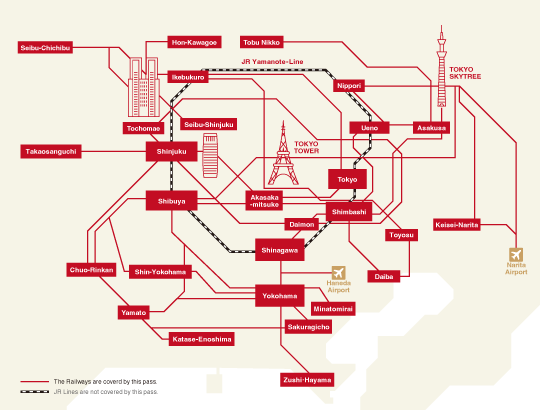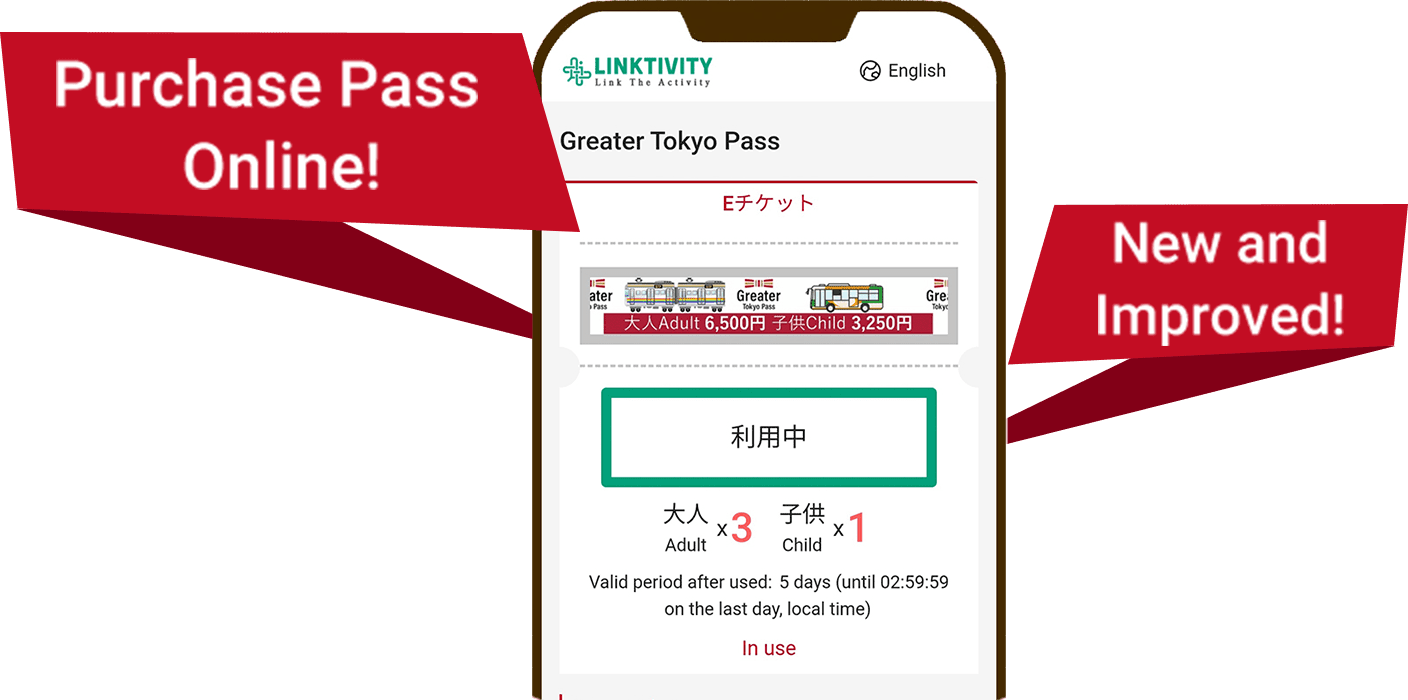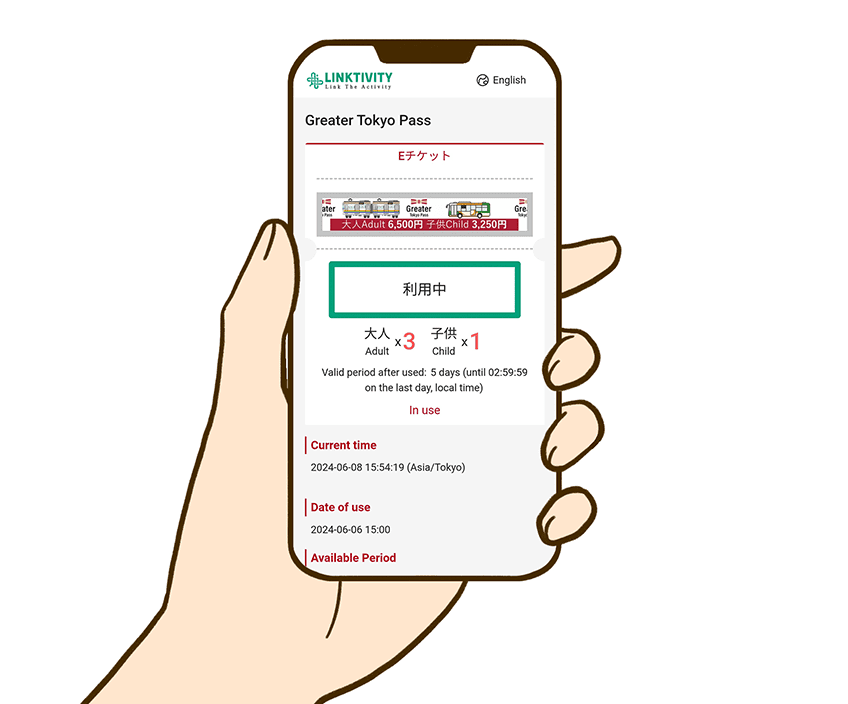About Greater Tokyo Pass
Purchasers of the Greater Tokyo Pass can take advantage of unlimited rides on railways, trams and Toei buses for the pass price, enabling them to save money as they enjoy sightseeing in the Kanto area.
A pass to go around
Tokyo and
the suburbs
by private railway or Toei Bus.
- #1
- The pass offers convenient travel with unlimited rides on 13 railways and tramlines and Toei buses in the Kanto area.
*The pass is not valid on certain train lines, including JR lines and the Tokyo Monorail, as well as buses not operated by Toei.
- #2
- Unlimited rides for 5 days.
Save money with the Greater Tokyo Pass.
Sightseeing map
Yokoze Terasaka Rice Terrace (Saitama Pref.)
moreOdaiba Marine Park (Tokyo)
moreSankeien Garden (Kanagawa Pref.)
moreNikko Toshogu Shrine (Tochigi Pref.)
moreEnoshima Island Area (Kanagawa Pref.)
moreNaritasan Shinshoji Temple (Chiba Pref.)
moreMt. Takao (Tokyo)
moreYokohama Chinatown (Kanagawa Pref.)
more
Tokyo Metropolitan Government Office (Tokyo)
moreMorito Kaigan Beach (Kanagawa Pref.)
moreShibuya (Tokyo)
moreAsakusa Kaminarimon (Tokyo)
moreAttention Notes
●Details for the Special Ticket
-
Only foreign visitors to Japan are eligible to use this ticket; valid passports must be presented. It is not available for foreign residents in Japan or Japanese citizens.
-
All riders must be foreign visitors in Japan, and the maximum number of people allowed to ride simultaneously is eight.
-
By presenting the ticket once, the total number of passengers riding simultaneously must not exceed the allowed capacity. Passengers cannot be split into separate groups.
-
If you are traveling on a paid express train or a train with reserved seating, please ensure that you have purchased a separate limited express ticket or reserved seat ticket.
-
An additional fare will be charged if you board or disembark in a section that crosses over designated areas.
-
In case of a disruption in a boardable section, alternative transportation can be used.
-
The validity period is five consecutive days from the date of first use. Each day is considered from 3:00 AM to 2:59 AM the following day.
-
If usage starts between 00:00 AM and 2:59 AM, the period from 00:00 AM to 2:59 AM is considered as one day. Therefore, from 3:00 AM, there are four days remaining.
-
The voucher is valid for three months from the issue date (when it can be used).
●How to Use
-
Only valid tickets can be used for boarding. Reservation confirmation emails and vouchers cannot be used for boarding.
-
Press the “USE” button to start using the ticket.
-
Present a valid ticket to station staff or bus crew. Automatic ticket gates cannot be used.
-
Please check with each transportation operator regarding using ticket gates without staff.
●How to Purchase
-
If you need receipts or other purchase-related information, please check with the agent where you purchased the ticket.
●Information Regarding Refunds and Reissues
-
You can receive a refund for the total ticket amount before using it. However, the handling and refund fees are subject to the rules of the specific agent that issued the ticket. Some agents may not offer refunds for your ticket.
-
Refunds can only be processed at the agent where you originally purchased. Please verify with the agent where you made your purchase. Refunds cannot be obtained at station counters, etc.
-
Refunds cannot be issued once you have started using the ticket, regardless of the reason. Even if service is suspended due to inclement weather, the validity period cannot be extended, and refunds will not be issued. Refunds are not available due to changes in the ticket price.
-
Refund fees are determined by the rules of the agent where you made your purchase.
-
Reissues are not possible in the event of theft or loss.
●Regarding Fraudulent Use
-
If such activity is detected, an additional fare may be charged, the ticket may be invalidated, or both actions may be taken. - We emphasize the collective responsibility of all passengers. In the case of multiple people, if even one person is found to be fraudulent, all tickets sold will be considered invalid. The following are considered fraudulent use:
-
When a person other than the designated ticket holder uses the ticket.
-
When the number of riders exceeds the number of tickets sold.
-
When a user fails to carry a passport while using the ticket.
-
When the person named on the ticket is not using it.
-
For railway and tram transport operators, when a passenger boards a train using an invalid ticket as per the passenger business regulations of the operator.
-
For bus operators, when a passenger uses a ticket that is invalid according to the provisions of the General Passenger Bus Transport Business Transportation Conditions established by the Bureau of Transportation Tokyo Metropolitan Government.
●Issues, Troubles, and Usage Devices
-
In case of operational issues, alternative transportation may be used. Refunds and extensions of validity are not available.
-
Digital devices that do not function due to dead batteries or malfunctions cannot be used. Please repair your digital device or contact the store where you bought it.
-
If your digital device runs out of battery or malfunctions when you exit the station, you will be charged the regular passenger fare from the boarding station or the furthest station on the company's line if the boarding station is unknown.
●Inquiries
-
We appreciate your decision to purchase the pass. For any queries, please contact the agent from which you purchased the pass directly. Station staff or bus crew will not inquire on your behalf to the agent.
-
For the official rules and regulations on using the pass, please refer to the "Agreement" on the GTP Council website. It is located at the bottom of https://greater-tokyo-pass.jp/
Sightseeing map
Yokoze Terasaka Rice Terrace (Saitama Pref.)
One of the largest rice terraces in Saitama Prefecture sits in a wonderfully scenic location against a mountainous backdrop that includes Mt. Buko. Enjoy farmland views in all seasons, through early summer rice planting, early autumn harvests, and red spider lily blooms. The annual Terasaka Rice Terraces Firefly Kagari Fire Festival is held on Saturday evenings in early July.
Access
Approx. 15-minute walk from Yokoze Station on the Seibu-Chichibu Line.
Sightseeing map
Odaiba Marine Park (Tokyo)
The views from Odaiba Marine Park are some of the best in Tokyo! The Rainbow Bridge, Tokyo Tower, and a replica of the Statue of Liberty unfold in a panorama that is powerful, yet graceful and soothing to create a dream-like world.
Reference
* Rainbow Bridge is specially lit up in two different patterns, one for summer (April to October) and one for winter (November to March).
Access
4-min. walk from both Odaiba-kaihinkoen Station and Odaiba Station on the Yurikamome Line.
Sightseeing map
Sankeien Garden (Kanagawa Pref.)
This Japanese garden was made by Sankei Hara, a businessman and master of tea ceremony. The spacious 175,000m2 premises include 17 historical buildings including ten national important cultural properties and three tangible cultural properties designated by Yokohama City.
Access
Approx. 28 min. by Yokohama Municipal Bus from Sakuragicho Station on the Yokohama Municipal Subway. Get off at Sankeien Iriguchi bus stop.
*The Greater Tokyo Pass is not valid on Yokohama municipal buses.
Sightseeing map
Nikko Toshogu Shrine (Tochigi Pref.)
This shrine enshrines the famous Japanese historical figure Ieyasu Tokugawa who started the Edo Shogunate. The shrine is famous for its wooden sculptures including the Three Monkeys, the Sleeping Cat and the Sparrow. It was designated as a World Heritage Site in 1999 as part of the Shrines and Temples of Nikko.
Access
Approx. 6 min. by Tobu Bus from Tobu Nikko Station on the Tobu Nikko Line.
Sightseeing map
Enoshima Island Area (Kanagawa Pref.)
This area is full of popular attractions, including beautiful flowers and food during all four seasons. The lighthouse is a symbol of the island, and Enoshima Shrine is a valuable historical asset. Visit the impressive Enoshima Aquarium featuring fish from the sea near Enoshima.
Access
Approx. 3-min. walk from Katase-enoshima Station on the Odakyu Enoshima Line.
Sightseeing map
Naritasan Shinshoji Temple (Chiba Pref.)
Three million people visit here for the first temple visit of the year to pray to Acala, the Wisdom King of Naritasan. This temple is especially famous for the must-see Goma Prayer (fire ceremony) involving people writing prayers on goma sticks (small pieces of cedar) wishing for things such as family safety, warding off evil spirits or traffic safety and putting them into a fire.
Access
Approx. 10-min. walk from Keisei Narita Station on the Keisei Main Line.
Sightseeing map
Mt. Takao (Tokyo)
This mountain is located on the eastern edge of the Kanto Mountains outside of Tokyo. This mountain is listed in the Michelin Guide as the most climbed mountain in the world, with over three million hikers coming here every year.
Access
Close to Takaosanguchi Station on the Keio Takao Line.
Sightseeing map
Yokohama Chinatown (Kanagawa Pref.)
Yokohama Chinatown is a neighborhood of traditional food and culture kept alive by the second, third, and fourth generations of Chinese who came to Japan when the Yokohama Port opened.
Enjoy lunch, dinner, and a stroll past shops selling Chinese goods.
You won’t want to miss the charming Chinese-style buildings, most notably the Zenrin Gate and the West, East, North, and South gates, the Mazu Miao temple and Kuan Ti Miao temple!
Yokohama’s Chinatown warmly welcomes visitors with its We Are Chinatown sign.
Access
Short walk from Motomachi-Chukagai Station on the Minatomirai train line
Sightseeing map
Tokyo Metropolitan Government Office (Tokyo)
This building is home to government institutions in Tokyo. The 243-meter tall Tokyo Metropolitan Main Building No.1 has an observation deck free of charge on the 45th floor with a view of Tokyo Tower, TOKYO SKYTREE, and on a clear day, Mt. Fuji.
Access
Close to Tochomae Station on the Toei Subway Oedo Line.
Sightseeing map
Morito Kaigan Beach (Kanagawa Pref.)
This resort area and spacious beach coastline in Hayama is filled with the allure of a gentle climate and breathtaking ocean. You can see Mt. Fuji and Enoshima Island from the beach, and the view at sunset is especially intoxicating.
Access
Approx. 8 min. by Keikyu Bus from Zushi・Hayama Station on the Keikyu Line. Close to Morito Kaigan bus stop.
*The Greater Tokyo Pass is not valid on Keikyu buses.
Sightseeing map
Shibuya (Tokyo)
This center of youth culture is one of Tokyo’s most popular spots. The area has a complete line-up of fashionable restaurants, cafes and shops. Among these, SHIBUYA109, close to the statue of Hachiko, is a popular shopping mall featuring all the latest trends.
Access
Close to Shibuya Station on the Tokyu Toyoko Line / Den-en-toshi Line.
Sightseeing map
Asakusa Kaminarimon (Tokyo)
The face of Asakusa enshrines Fujin, god of wind, on the right and Raijin, god of thunder, on the left to prevent natural disasters. The lantern hanging in the center of the gate is 3.9 m high with a diameter of 3.3 m and weight of 700 kg, making this a great picture taking spot.
Access
5-min. walk from Exit 1 of Asakusa Station on the Tokyo Metro Ginza Line.
5-min. walk from Asakusa Station on the Tobu Skytree Line.
5-min. walk from Exit A4 of Asakusa Station on the Toei Asakusa Line.




